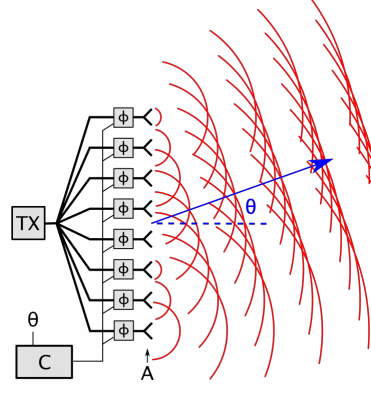VASBEAM
PHASED ARRAY
Phased array antennas are a type of antenna array that comes with the feature of electronic steering to change the direction and shape of radiated signals, without any physical movement of the antenna. The phase difference between the radiated signals from each antenna in the array is responsible for this electronic steering. The fundamental principle of the phased array antenna is the phase-dependent superposition of two or more radiated signals. When the signals are in-phase, they combine together to form a signal of additive amplitude. When the signals are counter phase, they cancel each other. Phased antenna arrays operate on this principle to achieve improved signal strength, gain, directivity, and performance over individual antennas. The number of emitters in a phased array antenna can range from a few into the thousands.

Beamforming
In an array antenna, the fields from the individual elements add constructively in some directions and destructively (cancel) in others thus creating an overall array radiation pattern different from that of the individual elements. Hence it can dynamically alter the radiation pattern depending upon the usecase and requirements.
Beamforming with phased array antennas is necessary at high frequencies to overcome losses during transmission. Phased array technology has helped enhance the characteristics of the collective signal or radiation pattern.
Enhancements
Power: The power of the collective signal is the summation of the individual signal powers; therefore, the strength is increased.
Beamforming: Shape of beam can be controlled by the phase difference of the individual signals and the radiation pattern of the phased array antenna is narrow compared to single antennas.
Beam Steering: The elimination of mechanical repositioning makes the beam steering or beam positioning flexible. The beam steering is established using electronically variable phase shifters.
Multi-Beams: With help of phase shifters, hundreds of beams can be synthesized in phased array antennas.
Weight: The weight of phased array antennas is less than the mechanically-steered single antenna.
Cost: A mechanically-steered antenna can be replaced by a less expensive phased array antenna, keeping the same resolution.
Reliability: The reliability of phased array antennas is much greater than single antennas. If one array antenna becomes impaired, the remaining antennas in the array will continue to function with a slight modification of radiation pattern.
The critical advantage for VASBEAM to develop Adaptive Antenna Systems is ownership of the Beamforming ASIC which is already in production